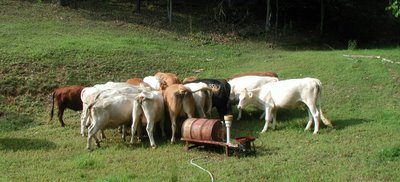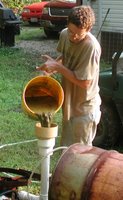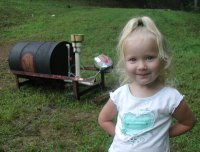Butt holes contributing to a self sufficient home

One of our goals with this house from the beginning has been to build a self-sufficient home. At the outset, I designed the largest continuous wall and roof plane of the house to face solar south. The south wall will have lots of windows for passive solar heat gain and the south roof will be covered in solar electric panels. Solar electricity is currently very expensive - it will take approximately 30 years for our solar panels to produce enough cumulative electricity to justify their initial purchase price (if energy prices remain constant). Given the high price of solar electricity (relative to the coal and gas fired electricity I could buy from the grid), it makes little sense to operate appliances like ovens, stoves, and clothes dryers with solar electricty. In fact, it's almost a prerequisite to operate these heat generating appliances from natural gas or propane if you're going to live off the grid and generate your own electricity. But, aye, there's the rub. Isn't it self-defeating to build an off-grid house that must also run on propane or natural gas? It seems to me like trading one devil for another. Unless...
 One renewable source of natural gas that has intrigued me, ever since I started raising cattle on this farm, is the conversion of cow manure to methane. I've read about it on the internet and in some 1970's books on self-sufficient houses, but I was never sure how difficult it would be to do it myself. (just like timber framing!) The best way to learn is to try, so a few weeks ago I plumbed an old 55 gallon oil barrel, poured out some salt and minerals on the ground, called for my cattle to join me in the back yard, and waited for them to poop everywhere. I followed them around with a shovel and a 5 gallon bucket for about an hour. I filled the 55 gal drum with a slurry of cow poop and water and waited for several days. Would it work? Would the traces of old diesel fuel in the drum or the chlorine in the tap water prevent bacterial methane production?
One renewable source of natural gas that has intrigued me, ever since I started raising cattle on this farm, is the conversion of cow manure to methane. I've read about it on the internet and in some 1970's books on self-sufficient houses, but I was never sure how difficult it would be to do it myself. (just like timber framing!) The best way to learn is to try, so a few weeks ago I plumbed an old 55 gallon oil barrel, poured out some salt and minerals on the ground, called for my cattle to join me in the back yard, and waited for them to poop everywhere. I followed them around with a shovel and a 5 gallon bucket for about an hour. I filled the 55 gal drum with a slurry of cow poop and water and waited for several days. Would it work? Would the traces of old diesel fuel in the drum or the chlorine in the tap water prevent bacterial methane production?The 55 gal drum is of course a scaled down prototype of what I would use for my house gas generation. I think I will need about a 1,000 gallon tank (already bought it at a farm auction for $50) and the manure of 7 confined cattle. My cattle are free-ranging, but I have 40 head, and I think that if I place a concrete pad in a central location where my cattle come to get their water and minerals, I can capture the equivalent manure of 7 confined cattle in this loafing area. I'd use a hose to wash the pad off occasionally (when it wasn't raining frequently enough) into a drain that would gravity feed to the methane digester. That's the big plan... now back to the small plan...
Within a few days, I had bubbles coming out the water trap of my methane digester. I didn't get too excited because I surmised these bubbles would be CO2 - the result of "aerobic" microbes. I hadn't purged the drum of oxygen, so based on what I've read, it is normal to expect aerobic digestion to occur for several days as a precursor to anaerobic digestion. Each day, there were more bubbles... venting to the atmosphere, because I had resolved not to waste my time with building the gas-storage stage of the methane digester until it actually produced methane gas. Seemed like a good idea at the time - but I soon found that my logic was flawed. You see, at night, the temperature (and therefore pressure) of the digester dropped low enough that it sucked the feed pipe of my digester empty, allowing oxygen to enter the digester every night. I would need a gas storage aparatus... if for no other reason than to accomodate the 24 hour rhythmic pressure differences in the digester. But what to use?
 I told my wife... I need one of those mylar balloons. My 2 year old daughter overheard me. She had watched the older kids help me build and fill the digester, but now she saw her chance to contribute. Quickly she volunteered... "I have berry cake balloon. You can use it." She went in the house and came out with a balloon that still held helium. I tried to explain the irreversible consequences of her intended donation, and she nodded her head that it would be fine, but I was certain she couldn't fathom it. The moral dilema was gut wrenching for me... would I actually empty my daughter's perfectly bouyant helium-filled Strawberry Shortcake balloon and fill it with artificial cow flatulence? Of course I would! I rationalized that methane (CH4) is lighter than air, and although the helium release would be permanent, her balloon might actually float again with swamp gas in it.
I told my wife... I need one of those mylar balloons. My 2 year old daughter overheard me. She had watched the older kids help me build and fill the digester, but now she saw her chance to contribute. Quickly she volunteered... "I have berry cake balloon. You can use it." She went in the house and came out with a balloon that still held helium. I tried to explain the irreversible consequences of her intended donation, and she nodded her head that it would be fine, but I was certain she couldn't fathom it. The moral dilema was gut wrenching for me... would I actually empty my daughter's perfectly bouyant helium-filled Strawberry Shortcake balloon and fill it with artificial cow flatulence? Of course I would! I rationalized that methane (CH4) is lighter than air, and although the helium release would be permanent, her balloon might actually float again with swamp gas in it.I painted the drum black (except for the wonderfully ironic Quaker State logo on the side), to help with solar heat absorption. (Methane generation works best at some temperature range that I think is close to internal body temperature.) The balloon soon filled and then the overflow realease mechanism (a msaon jar with water) vented bubbles into the atmosphere. At night, the balloon got saggy, but allowed no new oxygen to enter the digester. Surely this could be working now! But I got busy with the house - really busy. I watched the balloon inflate and bubbles release every day... and weeks passed. Was I really generating methane? How much? When would the first charge of manure run out? I needed to conclude the experiment soon, before daily temperatures dropped too low for my uninsulated methane digester to be viable.
 Finally, yesterday, I got up my courage to try and light some of the gas in the balloon. At first I couldn't really get anything to light. But I didn't have a proper aparatus for burning gas - I was simply trying to squeeze gas out of the balloon (through clear U-shaped hose with a water trap in the bottom for safety). Every time I got gas flowing out of the pipe, water would spurt out with it and extinguish my pilot light. The gas didn't seem explosive, so I dispensed with the water trap and started squeezing the gas out of the balloon straight on to a pilot flame. Eureaka. Although I couldn't develop a self-sustaining flame (because I lacked a proper burner), I could squeeze gas directly on to a flame (with the balloon under my arm and actuating it like bagpipe bellows) and get a much hotter, bigger, bluer flame than the pilot flame itself. My next step will be to find a proper burner/orfice and see if the gas is pure enough to provide a self-sustaining flame. In the mean time, I think my digester is making some Berry Sweet gas! [Kids, and litigious adults, please don't try this at home!]
Finally, yesterday, I got up my courage to try and light some of the gas in the balloon. At first I couldn't really get anything to light. But I didn't have a proper aparatus for burning gas - I was simply trying to squeeze gas out of the balloon (through clear U-shaped hose with a water trap in the bottom for safety). Every time I got gas flowing out of the pipe, water would spurt out with it and extinguish my pilot light. The gas didn't seem explosive, so I dispensed with the water trap and started squeezing the gas out of the balloon straight on to a pilot flame. Eureaka. Although I couldn't develop a self-sustaining flame (because I lacked a proper burner), I could squeeze gas directly on to a flame (with the balloon under my arm and actuating it like bagpipe bellows) and get a much hotter, bigger, bluer flame than the pilot flame itself. My next step will be to find a proper burner/orfice and see if the gas is pure enough to provide a self-sustaining flame. In the mean time, I think my digester is making some Berry Sweet gas! [Kids, and litigious adults, please don't try this at home!]


7 Comments:
Thanks JM. I hope other people enjoy it too. Do you have a blog? I went to your profile but couldn't find a link to a blog - maybe I'm incompetent though! :)
I am really impressed. And no we won't try this here in the middle of a Chicago neighborhood :)
I heard of your blog from jm BTW.
I can see where a methane digester might not go over well in your back yard! :)
This was a very fun read. You are a genious!
I looked into this a LONG time ago, and I still think it's really interesting. However, I think your 1000 gal tank is a mistake. As I recall, once the methane production ends, there is a thick, nitrogen rich material that will accumulate and will need to be removed. The good news? This forms a fantastic fertilizer and will be almost as valuable as the methane if you garden. I would make your methane generators out of 55 gal drums and use large tire innertubes as accumulators (they already have valves).
Check out this site, found it through Google when I was searching for similar info.
http://www.arti-india.org/content/view/12/28/
Dez
Dez,
Are there any free plans at that site? If not, I'm inclined to delete this hyperlink in one week if I don't hear back from you. Sorry... trying to keep the blog spam-free and it's hard to tell if that link leads to anything fruitful.
Post a Comment
<< Home